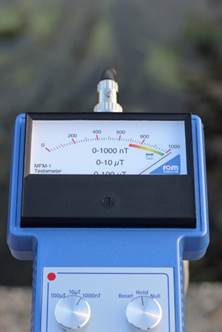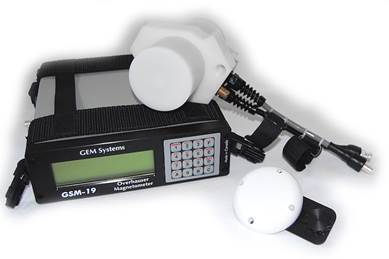Magnetometer

Disclaimer: Copyright infringement not intended.
Context
- Indian scientists have developed an Overhauser Magnetometer, one of the most accurate magnetometers extensively used by all magnetic observatories around the world.
Magnetometer
- A magnetometer is a device that measures magnetic field or magnetic dipole moment. Different types of magnetometers measure the direction, strength, or relative change of a magnetic field at a particular location.
- A compass is one such device, one that measures the direction of an ambient magnetic field, in this case, the Earth's magnetic field.
- Other magnetometers measure the magnetic dipole moment of a magnetic material such as a ferromagnet, for example by recording the effect of this magnetic dipole on the induced current in a coil.
Overhauser magnetometers
- Overhauser magnetometers use proton precession signals to measure the magnetic field. The Overhauser effect (dynamic nuclear polarization) is a transfer of energy from large electron magnetic moments to protons in the same sample.
- Overhauser magnetometers are more resistant to field gradients than classical proton magnetometers and they also measure faster.
Types of Magnetometers in a nutshell
Scalar Magnetometers
Scalar magnetometers perform an accurate measurement of the numeric value of the magnetic field. Each type is based on different physical phenomena:
Hall effect: Sense the voltage induced across an electrical conductor when applying a magnetic field can be perfectly used to measure magnetic fields
Proton precession (PPM): Make use of nuclear magnetic resonance to measure the resonance of protons in the magnetic field, measuring the voltage induced in a coil due to their reorientation
Overhauser: Similar to the Hall effect and proton precession magnetometers, but use radio-frequency signals to polarize the electron spins
An Overhauser magnetometer for geophysical applications.

Fig: Overhauser Magnetometer
Vector Magnetometers
Inductive: Measure the dipole moment of some particles by measuring the current induced in some detection coils after having subjected the sample to a variating magnetic field
Fluxgate: Composed of a magnetic ring core with at least two coil windings: the drive winding and the sense winding. Fluxgate magnetometers windings.
Hall effect: Generate a voltage proportional to the magnetic field and provide information about its module and direction; widely used for sensing applications rather than for characterizing magnetic materials
Microelectromechanical system (MEMS): Detect the motion of a resonant structure using optical means at the microscopic scale. MEMS magnetometers are cheap and accessible. Image used courtesy of Sparkfun Electronics
Gradient Magnetometers
Although each gradient magnetometer is a little different, each roughly has the same elements. First, they require a device to generate a known magnetic field, which can be alternating or constant. Second, gradient magnetometers require a source for an alternating gradient field. Finally, they also require an electronic or optical means to detect and measure the resultant force.
They also all have resonant operation, so the magnetic samples move around their resonant frequency when the maximum amplitude is achieved.
Another relevant aspect of magnetometers is the orientation of the magnetic field. In some magnetometers, such as the Zijlstra’s, the alternating and DC field were both aligned and oriented vertically. In contrast, in Foner’s magnetometer, the sample vibrates perpendicularly to the magnetic field, which reduces the complexity of the necessary set-up.
Vibrating Reed Magnetometer
Zijlstra introduced one of the first alternating gradient magnetometers in 1970. It was intended to overcome the limitation of previous magnetometers and measure the complete hysteresis curve of magnetic materials.
The most prominent difference between Zijlstra’s magnetometers and the previous ones is the sensitivity and also the capability to completely characterize magnetic materials. To have full magnetic characterization, samples need to be very small to avoid imperfections, the problem is that magnetometers able to characterize samples with the size of microns can only characterize some magnetic properties such as the remanence or the susceptibility, but not the complete hysteresis cycle.
Vibrating Sample Magnetometers (VSM)
Most devices that measure the magnetic moment have a detection coil horizontally aligned with the coils generating an alternating magnetic field. Vibrating sample magnetometers (VSM), invented by Foner in 1959, introduced the novelty that the sample motion is perpendicular to the applied magnetic field. Foner reduced the complexity of the set-up, avoiding hard modifications of the magnets.
VSMs are present in many laboratories and commercially available. A commercial vibrating sample magnetometer (VSM).
Combined Alternating Field Magnetometers
There is a third category of magnetometers that combines characteristics of the previous ones; they are so-called combined magnetometers. They still use two magnetic fields; however, instead of applying only one alternating field and another constant one, they apply two alternating fields. The greatest advantage is the characterization of samples in AC, as well as in DC, compared to VSMs or other magnetometers that are limited to DC fields.
When varying both frequencies, the device works as a susceptometer, measuring high-order harmonics of the magnetic moment. This type of magnetometer was invented in 2015 by researchers at the Technical University of Madrid.
Use of Magnetometers
- Magnetometers are extensively used in various applications like geographical surveys, archeological surveys, metal detectors, space explorations, etc. to detect the mineralization and geological structures. In the oil and gas industry, these meters play an important role for a directional drilling process. These meters are available based on the type of applications like land, airborne, marine, and micro-fabricated atomic magnetometers.
- Magnetometers are widely used for measuring the Earth's magnetic field, in geophysical surveys, to detect magnetic anomalies of various types, and to determine the dipole moment of magnetic materials. In an aircraft's attitude and heading reference system, they are commonly used as a heading reference.
- Magnetometers are also used by the military as a triggering mechanism in magnetic mines to detect submarines. Consequently, some countries, such as the United States, Canada and Australia, classify the more sensitive magnetometers as military technology, and control their distribution.
- Magnetometers can be used as metal detectors: they can detect only magnetic (ferrous) metals, but can detect such metals at a much greater distance than conventional metal detectors which rely on conductivity. They are capable of detecting large objects, such as cars, at over 10 metres (33 ft), while a metal detector's range is rarely more than 2 metres (6 ft 7 in).
- In recent years, magnetometers have been miniaturized to the extent that they can be incorporated in integrated circuits at very low cost and are finding increasing use as miniaturized compasses.
Applications of Magnetometer in a nutshell
Archaeology
To detect the archaeological sites, buried and submerged objects
Coal exploration
Used to locate the sills and other obstacles which result in an explosion
Military applications
Used in defense and navy to perform the submarine activities.
Defense and aerospace
Used on land, in the air, at and undersea, and in space applications
Oil and gas exploration
Used while drilling the discovered wells
Drilling sensors
Used to detect the direction or path for the drilling processes
Plasma flows
Used while studying about the solar wind and planetary body
Health care monitoring
Used to perform cardiac applications like diagnostic system capable of non-invasively measure of heart function
Pipeline monitoring
Inspecting corrosion of the pipeline in the underground systems and also for monitoring purposes these are used
Surveyors
Used in the geophysics applications
Compasses
Space applications
Image processing of the magnetic data




1.png)
